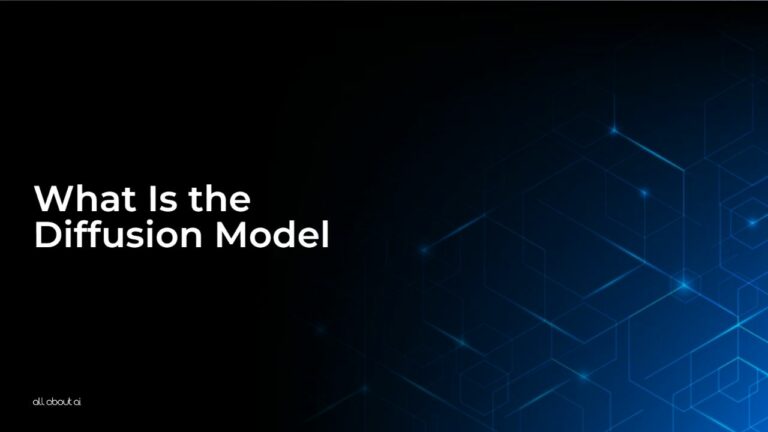What is the Diffusion Model? In artificial intelligence, the diffusion model refers to a machine learning framework that progressively transforms data from a simple, random distribution into a more complex one that represents the desired outcome. It’s an iterative process that involves gradually adding details and patterns to generate sophisticated outputs, often used in areas like image and audio synthesis.
This article, written by the AI experts at All About AI, will discuss the ins and outs of the diffusion model. Read on.
Examples of the Diffusion Model
Image Generation: AI systems leveraging the diffusion model can create stunningly realistic images. Starting from random noise, these systems iteratively refine the image, adding details and textures, culminating in high-resolution, lifelike visuals.
Audio Synthesis: In audio synthesis, diffusion models progressively enhance basic sound waves into complex audio tracks. This process can generate everything from human-like speech to intricate musical compositions, demonstrating remarkable versatility.
Data Augmentation: Diffusion models aid in data augmentation by generating new data samples. This is particularly useful in machine learning, where enriched datasets help in training more robust models, leading to improved generalization.
Text-to-Image Conversion: This application involves transforming textual descriptions into corresponding images. The diffusion model iteratively builds upon a base image, intricately aligning it with the nuances of the given text description.
Use Cases of the Diffusion Model
Pharmaceutical Research: In pharmaceuticals, diffusion models aid in predicting molecular structures. They start with basic molecular frameworks and iteratively add atomic details, facilitating the discovery of potential new drugs.
Climate Modeling: Diffusion models are used in climate science to simulate complex weather patterns. Starting from basic atmospheric data, these models iteratively enhance the details, offering insights into future climate scenarios.
Virtual and Augmented Reality: In virtual and augmented reality, diffusion models enhance realism by progressively refining virtual environments. This gradual enhancement process leads to immersive and detailed virtual worlds.
Behavior Prediction: These models can predict user behavior by gradually refining data patterns. They start with basic behavioral trends and iteratively add layers of complexity, aiding in personalized recommendations and targeted marketing.
Pros and Cons
Pros
- The diffusion model excels in generating high-quality outputs, from images to audio, by progressively refining data.
- Its adaptability allows for applications across different fields, including healthcare, entertainment, and science.
- The model improves its output quality over iterations, leading to increasingly accurate and realistic results.
- It is particularly effective in dealing with complex, high-dimensional data, making it suitable for advanced artificial intelligence tasks.
Cons
- The iterative process is computationally intensive, requiring significant resources and time, especially for high-resolution outputs.
- The model’s effectiveness heavily relies on the quality of the input data; poor quality inputs can lead to subpar outputs.
- There’s a risk of overfitting, where the model becomes too tailored to the training data, reducing its generalizability.
- Understanding and interpreting the intermediate stages of the model can be challenging, which might hinder troubleshooting and refinement.
FAQs
What makes the diffusion model unique in AI?
The diffusion model’s unique attribute lies in its iterative process of refining data, transforming simple distributions into complex, detailed outputs. This approach sets it apart in generating highly realistic and accurate results in various applications.
How does the diffusion model contribute to image generation?
In image generation, the diffusion model progressively adds detail to initial noise, resulting in high-quality, realistic images. This iterative refinement process allows for the creation of intricate visuals with depth and clarity.
Can the diffusion model be used in audio synthesis?
Yes, the diffusion model is adept at audio synthesis. It starts with basic sound waves and incrementally adds layers of complexity, enabling the creation of rich, natural-sounding audio, including speech and music.
What are the challenges associated with the diffusion model?
The primary challenges of the diffusion model include its computational intensity, reliance on high-quality input data, risk of overfitting, and difficulties in interpreting the intermediate stages of the model’s process.
Key Takeaways
- The diffusion model is a machine learning framework that iteratively transforms simple data into complex, detailed outputs.
- Its applications span across image generation, audio synthesis, data augmentation, and text-to-image conversion.
- It’s beneficial for its generative capabilities and adaptability but faces challenges like computational demands and interpretability issues.
- Real-world use cases include pharmaceutical research, climate modeling, virtual and augmented reality, and behavior prediction.
- Understanding its unique iterative process is key to appreciating its role in advancing AI technology.
Conclusion
The diffusion model represents a significant stride in artificial intelligence, transforming basic data into intricate and realistic outputs. This article has explored its definition, examples, use cases, pros and cons, and addressed common queries, providing a comprehensive view of this influential AI framework.
This article aimed to answer the question, “what is the diffusion model,” explaining this AI concept in terms of AI. If you’re looking to deepen your understanding of AI concepts and terminologies, visit our extensive AI Definitions Index.





